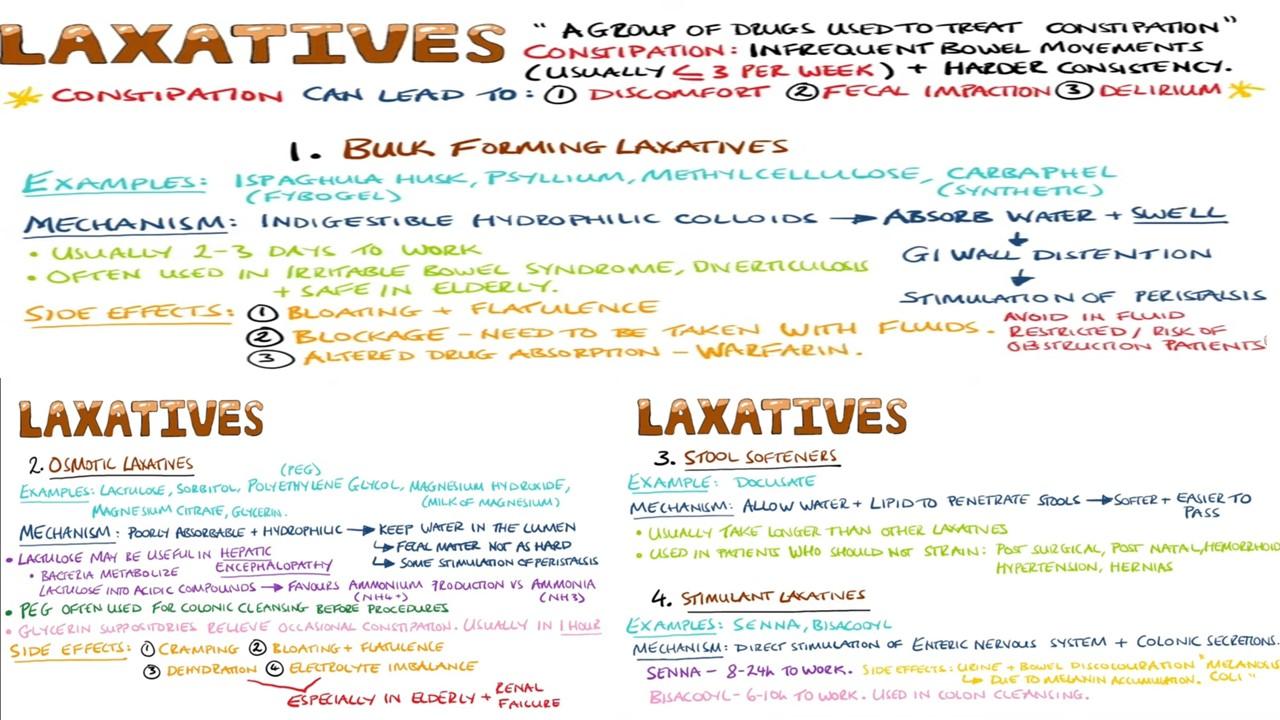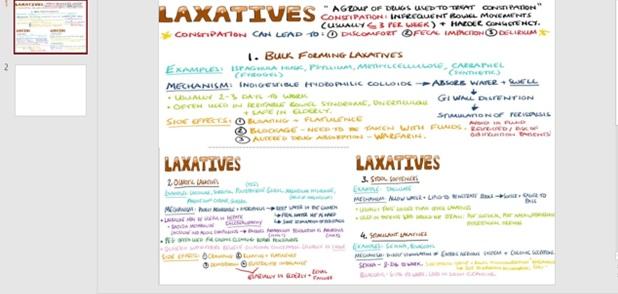Classification & Types
When a Laxative Should Be Used
A laxative should be used when the patient has a problem with fecal constipation: it is a medical condition when dense fecal masses move away with difficulty, and the stool is irregular and painful.
Bulk
Bulk laxatives, upon penetration into the gastrointestinal tract, begin to absorb water, stretch the intestinal walls and activate peristalsis; these are medicines of natural origin that are easily digested but not digested by the body. Examples of bulk laxatives are wheat bran, flaxseed, sterculia, agar-agar, cellulose, plantain seeds, sea cabbage, and figs (Hay et al., 2019). The bulk laxative type should be considered when the patient is a supporter of treatment with natural drugs that are not addictive, as well as in the initial stages of the disease. This laxative type is contraindicated when the drug should be used for a bedridden patient, as well as if the patient is a nursing or pregnant woman or a small child.
Osmotic
The basic principle of osmotic laxatives is to retain fluid inside the intestine. The contents are saturated with liquid, grow in volume, and, due to this, intestinal motility improves. Examples of osmotic laxatives are synthesized disaccharides (lactulose, lactitol, sorbitol) and saline laxatives: sulfates and vary salt (Hay et al., 2019). Osmotic laxative type should be considered when it is necessary to reduce the reproduction of pathogenic microorganisms, as well as for patients of children from the first days of life or nursing and pregnant women. This laxative type will be contraindicated if constipation is a consequence or side effect of another disease. Osmotic drugs will not be able to eliminate the root cause of impaired peristalsis.
Stimulant
Stimulant laxatives contain irritating substances that affect the nerve endings in the intestinal mucosa and cause intestinal contractions. Medications with a stimulating effect can act on different parts of the digestive tract. The area of action of castor oil and laxative resins is the small intestine (McRorie et al., 2020). Examples of stimulant laxatives are preparations of senna, buckthorn, rhubarb, sulfur, sodium pyrosulfate, and diphenylmethane derivatives (Hay et al., 2019). Stimulant laxative type should be considered when a single bowel movement is necessary 6-10 hours after drug administration (Hay et al., 2019). This laxative type should be contraindicated when the course of treatment is expected to be more than 14 days: this group of laxatives is highly addictive (Hay et al., 2019).
Surfactant
Surfactant laxative type retains water, swells, and stretches the walls of the intestine with an increased volume. Excessive stretching triggers peristalsis, and bowel emptying accelerates. Examples of surfactant laxatives are dietary fiber as well as macrogol. Dietary fiber is contained in bran, the shell of psyllium seeds, and flax (Hay et al., 2019). Surfactant laxative type should be considered when patients are elderly: this type of laxative is best tolerated by their intestines. This laxative type would be contraindicated when an instant effect is needed; also, these drugs are not recommended for people with kidney and heart diseases because salts can be absorbed into the bloodstream in minimal amounts and retain water in the body.
Caution of Laxative Overuse
Symptoms of Laxative Overuse
The main symptoms of laxative abuse are chronic diarrhea, vomiting, abdominal pain, lethargy, thirst, weakness, edema, bone pain due to osteomalacia, and weight loss.
Long-Term Health Risks of Laxative Overuse
Long-term health risks include protein-depleting enteropathy, steatorrhea, pathological changes in the colon, acid-base imbalance, and hypokalemia.
Risk Group
People with mental disorders, deep personal experiences, and unstable psycho-emotional background are at risk of overuse with laxatives (Cobo et al., 2019). Most often, these are teenagers and young women who use laxatives to lose weight.
Possible Referrals
Someone who was experiencing laxative overuse should be referred to a psychologist. They should check the patient for the presence of a mental illness that negatively affects the physical and mental health of a person, which is characterized by abnormal consumption of laxatives in order to lose weight.
JPEG


References
Cobo, M. D., Beato, Z., Cabezón, G., Chicas, S., Blancas, F., García, N., … Soler, L. (2019). 1821P: Analysis of the efficacy of naloxegol in a real-world 12 weeks of follow-up study, in patients with cancer and opioid-induced constipation with laxative-inadequate response. Annals of Oncology, 30(5), 740-742.
Hay, T., Bellomo, R., Rechnitzerd, T., See, E., Yasmine, A. A., & Deane, A. M. (2019 Constipation, diarrhea, and prophylactic laxative bowel regimens in the critically ill: A systematic review and meta-analysis. Journal of Critical Care, 52(5), 242-250.
McRorie, J. W., Fahey, G. C., Gibb, R. D., & Chey, W. D. (2020). Laxative effects of wheat bran and psyllium: Resolving enduring misconceptions about fiber in treatment guidelines for chronic idiopathic constipation. Journal of the American Association of Nurse Practitioners, 32(1), 15-23.